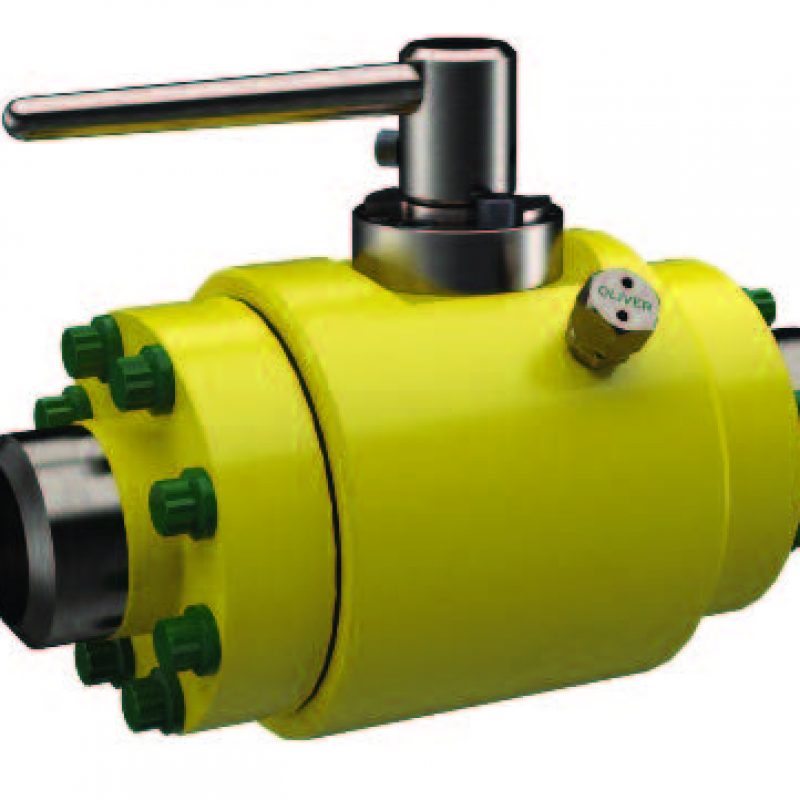Our Compact Style Single Ball Valves are designed to provide considerable space and weight savings when compared to a traditional flanged end ball valve. Available in both floating and trunnion ball designs, the valve utilises Oliver’s proven ball valve technology and can be supplied with either manual or automated actuation.
• Bi Directional Single Ball Valve with soft or metal seats.
• Swivel flange type construction, with butt weld hub connections.
• Floating Ball or Trunnion mounted design.
Compact Light Weight Design
Provides space and weight saving on platforms, reduced shipping and handling costs and minimal structural support.
Threaded Valve Insert
Designed to take full working pressure. Does not rely on mating flange to hold internals.
Oliver Swivel Flanges
Designed to allow hubs to be welded into line, before split rings and flanges are fitted. Valve can be fitted with no additional ‘springing’ of pipework.
Firesafe Design
O-ring seals and metal-to-metal contact on all static joints, graphite rings provide additional resistance to leakage in the event of fire.
Other Design Features
Anti-blow out stem design shouldering on the body (rather than the bonnet), Automatic cavity relief, Low friction dry stem bearings to minimise operating torques and maximise cycle life.
Valve can be supplied with mounting plate in accordance with ISO 5211 for actuator attachment.
Description Bore — Bi-directional, trunnion ball valve. NPS 1″ to 8″ [DN25 to DN200].
Pressure Rating — ASME Classes upto 2500.
Hydro Body Test
Pressure — 1.50 x working pressure.
Working Temperature — -50 to +400 deg F (-46 to +200 deg C).
Specifications — API6D Standard, ASME VIII DIV2, NACE MR-01-75
End Connections — Buttweld profile to ASME B16.25
Operator — ISO 5211 F10 interface for actuator.
Body and Trim Material — Alloy Steel, Stainless Steel, Duplex Steel or Nickel Alloys.
Seat Insert Material — PEEK.
Stem Material — Stainless Steel, Duplex Steel or Nickel Alloys.
Stem Seal Materials — PTFE lip seal with elgiloy spring.
Fire Safe Seals Material — Graphite.
Body Seal Materials — FKM or HNBR O-rings with PTFE back-up rings.
Bolting — Alloy Steel or Stainless steel.
Flange and Hub Material — Alloy Steel, Stainless Steel, Duplex Steel or Nickel Alloys.
Split Ring Material — AISI 4130 alloy steel Xylan coated.
Oliver Features and Benefits
1. Compact, light-weight design provides space and weight saving on platforms, reduced shipping and handling costs and minimal structural support.
2. Threaded valve insert, designed to take full working pressure. Does not rely on mating flange to hold internals. Significant safety advantage over competition.
3. Throughout design, in addition to o-ring seals and metal-to-metal contact on all static joints, graphite rings provide additional resistance to leakage in the event of fire. Competitors rely on metal to metal face contact.
4. Anti-blow out stem design shouldering on the body rather than the bonnet. Significant safety advantage over competition.
5. Stem seal located within valve body rather than separate valve bonnet as used by competitors. This removes a potential leak path.
6. Automatic cavity relief.
7. Low friction dry steam bearings to minimise operating torques and maximise cycle life. Competitors use highly stressed non-NACE stainless steel xylan coated bearings.
8. In addition to the spring energised lip seal stem seal, a graphite fire safe stem seal is provided. Competitors rely on small clearances to keep stem leak to a minimum during a fire test.
9. All o-rings are supplied in material which has been fully explosive decompression tested.
10. Coil spring between ball and spindle provides electrical continuity to prevent static build up.
11. Grease injection fitting has two inline tungsten carbide balls for maximum sealing integrity.
12. Valve can be supplied with mounting plate in accordance with ISO 5211 F10 for actuator attachment, optionally a lever handle can be provided.
13. All wetted materials are suitable for sour service as listed within NACE MR-01-75 / ISO 15156. Competitors used materials such as Nitronic 60 for some internals which is not listed in NACE.



 微信打开
微信打开